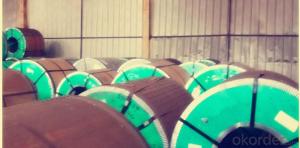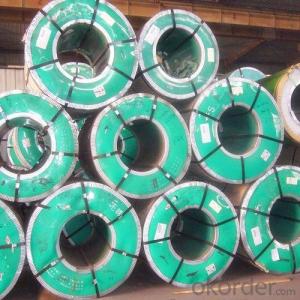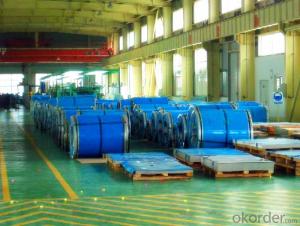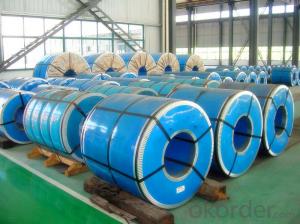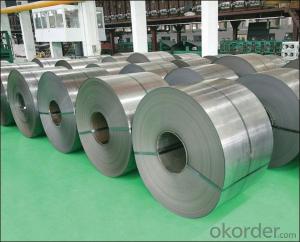Hot Rolled Stainless Steel Coil 304 Narrow Strip No.1 Finish
OKorder Service Pledge
OKorder Financial Service
You Might Also Like
Hot Rolled Stainless Steel Coil 304 Annealing and Pickling No.1 Finish Narrow Strip
1.surface:NO.1
2.standard:JIS, AISI, GB
3.width: 0.55m
Hot Rolled Stainless Steel Coil 304 Chemical Composition:
(%):C=0.07, Mn=2.00, P=0.045, S=0.030, Si=0.075, Cr=17.5-19.5, Ni=8.0-10.5, N=0.10
Hot Rolled Stainless Steel Coil 304 Physical Properties
Tensile strength σb (MPa) ≥ 520
the conditions yield strength σ0.2 (MPa) ≥ 205,
elongation δ5 (%) ≥ 40
Reduction of ψ (%) ≥ 50,
hardness: ≤ 187
HB; ≤ 90
HRB; ≤ 200H
Type | Hot Rolled Stainless Steel Coil 304 |
Thickness | 3.0mm-4.0mm |
Width | 550mm |
Length | according to weight |
Brand name | CNBM |
Standard | ASTM, AISI, DIN, GB, JIS etc |
Material | 304 |
Application | Foodstuff, Gas, metallurgy, biology, electron, chemical, petroleum, boiler, nuclear energy, Medical equipment, fertilizer etc |
Package | Standard export sea-worthy packing |
Delivery time | Within 15 days since getting the deposit or LC origin |
Surface | NO.1 |
Productivity | 20000 tons/month |
Grade: | 300 Series | Standard: | JIS,AISI,ASTM,GB,DIN,EN etc | Thickness: | 2.5mm, 3.0mm, 4.0mm |
Width: | 550mm | Length: | according to weight | Place of Origin: | China (Mainland) |
Brand Name: | CNBM | Model Number: | 304 | Technique: | Hot Rolled |
Application: | industry, construction, furniture, repairing | Certification: | MTC | Finishing: | NO.1 |
Market: | globle area | Packaged: | wooden and bags in cases as standard | Payment: | TT & LC |
Delivery time: | 15 days | MOQ: | 100 tons | Advantage: | prime quality, competitive price |
Profession: | hot rolled | Charactor: | stainless steel coils | Material/Grade: | 304 |
- Q:What is the cost of stainless steel strips?
- The cost of stainless steel strips can vary depending on factors such as the grade, thickness, width, and quantity needed. It is best to consult with a supplier or research current market prices for an accurate cost estimate.
- Q:Can 111 stainless steel strips be used in high-temperature applications?
- 111 stainless steel strips are not suitable for high-temperature applications. It is a type of stainless steel with low carbon content, commonly used for general purposes. Its maximum operating temperature is approximately 400-450 degrees Celsius (750-840 degrees Fahrenheit). To ensure adequate heat resistance and oxidation resistance at elevated temperatures, it is advisable to utilize stainless steel grades like 310, 316, or 321, which possess higher levels of chromium and nickel.
- Q:Can stainless steel strips be used in the aerospace engine components?
- Yes, stainless steel strips can be used in aerospace engine components. Stainless steel offers excellent strength, durability, and resistance to high temperatures, making it suitable for various engine parts such as turbine blades, combustion chambers, and exhaust systems. Additionally, stainless steel's corrosion resistance properties are vital in the aerospace industry, ensuring longevity and reliability in harsh operating conditions.
- Q:Are stainless steel strips suitable for elevator interiors?
- Yes, stainless steel strips are suitable for elevator interiors. Stainless steel is a durable and hygienic material that is resistant to corrosion, making it ideal for high-traffic areas like elevators. Additionally, stainless steel strips can also enhance the aesthetic appeal of the elevator interiors, providing a sleek and modern look.
- Q:What are the common uses of stainless steel strips in the textile industry?
- Stainless steel strips are widely used in the textile industry for various purposes due to their exceptional properties and characteristics. One common use of stainless steel strips in this industry is as reinforcement in textile belts and conveyor systems. These strips help to enhance the strength and durability of the belts, allowing them to withstand heavy loads and continuous operation without any deformation. Another common use of stainless steel strips is in the production of textile machinery components. These strips are used to manufacture various parts such as guide rails, needle plates, and cutting blades. Stainless steel's corrosion resistance and high temperature resistance make it ideal for these applications, ensuring a long lifespan and reliable performance of the machinery. Stainless steel strips are also utilized in the production of textile molds and dies. These molds are used for processes like fabric embossing or printing, where stainless steel strips provide excellent heat transfer and stability. The high tensile strength of stainless steel ensures that the molds can withstand the pressure and stress exerted during the manufacturing process. Moreover, stainless steel strips find application in textile weaving and knitting machines. They are used as wire guides, tensioning devices, and reed hooks, providing smooth and accurate movement of yarns during the weaving or knitting process. The corrosion resistance of stainless steel ensures that the strips do not degrade over time, maintaining their functionality and reliability. In addition, stainless steel strips are employed in textile dyeing and finishing processes. These strips are used as clips or pins to secure the fabric in place during dyeing or finishing, ensuring that it does not unravel or get distorted. Stainless steel's resistance to chemicals and high temperatures makes it suitable for these applications, as it can withstand the harsh conditions of the dyeing and finishing processes. Overall, stainless steel strips play a crucial role in the textile industry, providing strength, durability, and reliability in various applications. Their corrosion resistance, high temperature resistance, and excellent mechanical properties make them a preferred material for reinforcing belts, manufacturing machinery components, producing molds, and facilitating various processes in the textile manufacturing sector.
- Q:How does stainless steel strip perform in corrosive environments?
- Stainless steel strip excels in corrosive settings, showcasing exceptional performance. Its elevated chromium content prompts the formation of a safeguarding oxide layer on its surface upon exposure to oxygen, effectively thwarting further corrosion. This oxide layer acts as a shield against corrosive elements like moisture, chemicals, and saltwater, augmenting the stainless steel strip's resistance to corrosion. Moreover, stainless steel strip displays remarkable resistance to diverse acids, alkaline solutions, and organic compounds, rendering it an optimal choice for applications in industries like chemical processing, food processing, and marine environments. Its ability to resist pitting corrosion and crevice corrosion further enhances its efficacy in corrosive settings. Apart from its corrosion resistance, stainless steel strip also possesses other advantageous properties such as high strength, durability, and heat resistance, rendering it a dependable material for a wide array of applications. Whether employed in the production of equipment, components, or structures, stainless steel strip delivers enduring performance, even in demanding and corrosive conditions.
- Q:Can stainless steel strips be used in chemical reactors?
- Certainly, chemical reactors can utilize stainless steel strips. The chemical industry extensively employs stainless steel owing to its remarkable resistance to corrosion. Its ability to withstand diverse chemicals, such as acids, bases, and organic solvents, renders it suitable for application in chemical reactors. Stainless steel strips can be transformed into different forms and sizes to cater to the precise demands of a chemical reactor. Furthermore, stainless steel's exceptional strength and durability make it a perfect choice for enduring the harsh circumstances and pressures typically encountered in chemical procedures.
- Q:Can stainless steel strips be used in electronic applications?
- Stainless steel strips are indeed applicable for electronic purposes. Their exceptional corrosion resistance and mechanical properties render them suitable for a range of electronic components and devices. Connectors, terminals, springs, shields, and enclosures often utilize stainless steel due to its common usage. In electronic circuits, stainless steel strips guarantee dependable performance through their high strength and durability. Moreover, their non-magnetic properties make them an excellent fit for applications that demand minimal disruption to magnetic fields. All in all, stainless steel strips present numerous benefits for electronic use, which explains their popularity in the industry.
- Q:What are the different widths available for stainless steel strips?
- A variety of widths are offered for stainless steel strips to accommodate different needs and uses. The widths can vary based on the manufacturer and type of stainless steel employed. However, common widths include 1/2 inch, 3/4 inch, 1 inch, 1.5 inches, 2 inches, and 3 inches, among others. These examples represent just a small fraction of the available widths in the market. The selection of a particular width for stainless steel strips depends on factors like the intended application, project size, and desired strength and durability. To determine the most appropriate width for your specific needs, it is advisable to seek guidance from a supplier or manufacturer.
- Q:How do stainless steel strips resist heat?
- Stainless steel strips possess exceptional heat resistance due to their unique chemical composition and manufacturing process. The primary reason behind their ability to resist heat is the high content of chromium in stainless steel. Chromium is an alloying element that forms a protective oxide layer on the surface of the steel when exposed to oxygen. This oxide layer, known as chromium oxide, acts as a barrier against heat, preventing the steel from oxidizing or corroding at high temperatures. Moreover, stainless steel strips often contain other alloying elements such as nickel and molybdenum, which further enhance their heat resistance. Nickel helps to stabilize the austenitic structure of stainless steel, making it more resistant to deformation and maintaining its strength even at elevated temperatures. Molybdenum, on the other hand, increases the steel's resistance to pitting and crevice corrosion when exposed to high heat and corrosive environments. Additionally, the cold rolling process used to manufacture stainless steel strips contributes to their heat resistance. Cold rolling involves passing the steel through a series of rollers at room temperature, which not only gives the steel its desired thickness but also increases its mechanical properties. This process results in a more compact and denser structure, making the stainless steel strips better able to withstand thermal expansion and contraction without warping or losing their shape. In conclusion, the ability of stainless steel strips to resist heat can be attributed to the high chromium content, the presence of other alloying elements like nickel and molybdenum, and the cold rolling manufacturing process. All these factors work together to create a material that can withstand high temperatures, maintain its strength, and resist corrosion, making stainless steel strips widely used in various industries where heat resistance is crucial.
1. Manufacturer Overview |
|
|---|---|
| Location | |
| Year Established | |
| Annual Output Value | |
| Main Markets | |
| Company Certifications | |
2. Manufacturer Certificates |
|
|---|---|
| a) Certification Name | |
| Range | |
| Reference | |
| Validity Period | |
3. Manufacturer Capability |
|
|---|---|
| a)Trade Capacity | |
| Nearest Port | |
| Export Percentage | |
| No.of Employees in Trade Department | |
| Language Spoken: | |
| b)Factory Information | |
| Factory Size: | |
| No. of Production Lines | |
| Contract Manufacturing | |
| Product Price Range | |
Send your message to us
Hot Rolled Stainless Steel Coil 304 Narrow Strip No.1 Finish
OKorder Service Pledge
OKorder Financial Service
Similar products
New products
Hot products
Hot Searches
Related keywords
